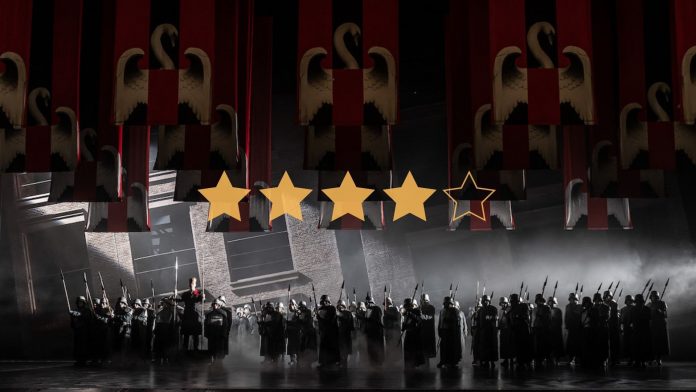★★★★✰
A society on the brink. A mythic hero arrives. But is he really here to save them? The dialectics of darkness and light take centre stage in David Alden’s gorgeously bleak production of Wagner’s Lohengrin, revived by Peter Relton at the Royal Opera House.
In Alden’s production the world of Brabant is dark and distorted, a cold atmosphere with large oppressive shadows swallowing the stage, alongside iron beams and brick walls. Set designer Paul Steinberg echoes the work of German Expressionist George Grosz whose cityscapes hold a contorted mirror to the desperation and decay of post-World War One Germany. It is a perfect visual parallel: a society in need of fantasy finds its hero. Enter Lohengrin, the mythic knight whose boat is carried by a magic swan.
Brandon Jovanovitch’s swave Lohengrin has swapped out a shimmering suit of armour for a slick white linen suit that slices through the grime like a beam of sunlight through a caliginous sky. The chorus, whose drab costumes evoke political refugees, welcome him as their almost messianic leader after he saves Jennifer Davis’s Elsa from death at the hands of Telramund. His swan is cleverly not physicalised on stage, but rather evoked through a glimmering lighting effect simulating fluttering wings. The entire cast, and audience, are mesmerised in its presence.
But Alden’s Lohengrin is not one of triumph or chivalric romance. The political intrigue, power play, and subterfuge are brought into the light. Gábor Bretz’s Henrich is portrayed as a Medici-like manipulator rather than a valiant king. Anna Smirnova as the Machiavellian Ortrud’s performance is delightfully crunchy. It is no wonder she can easily manipulate her husband, Craig Colclough as the devilishly narcissistic Telramund. His commanding vocal presence melts in hubris and jealousy, eventually spiralling into the tragic conclusion of the opera. Jenifer Davis returns from the original production to play Elsa, Lohengrin’s doomed lover. Since her 2018 debut, she has performed the role in opera houses across the world.
But the chorus, the townspeople of Brabant are the real victims in Alden’s production. By the final act, they are decked out in Nazi-esque uniforms and march under red and black banners garlanded with a swan, ready to fight and die for blood and soil. A lingering terror enshrouds the darkness around them. They are victims of their own desperation for fantasy, for a hero to lift them from the darkness.
The image of the swan is no longer a beacon of hope but an Orwellian boot stamping on the face of the townspeople. Even the wedding ceremony at the end of Act Two takes place under a neoclassical inspired statue that would not look out of place at a Nuremberg rally. The delicate beauty of Wagner’s music, particularly Lohengrin’s Grail motif, is thrown into a haunting disarray perhaps paralleling the real-life tension between his music and his political beliefs.
There are a plethora of essays and articles on Wagner’s Antisemitism and the appropriation of his music by Nazi Germany. Alden’s production is fully conscious of this problematic history, but instead of shying away from it, he weaves the tension into the production making for an astoundingly visceral rendition of Wagner’s romantic opera.
Lohengrin at the Royal Opera house runs until 14 May
Words by Alexander Cohen
Support The Indiependent
We’re trying to raise £200 a month to help cover our operational costs. This includes our ‘Writer of the Month’ awards, where we recognise the amazing work produced by our contributor team. If you’ve enjoyed reading our site, we’d really appreciate it if you could donate to The Indiependent. Whether you can give £1 or £10, you’d be making a huge difference to our small team.
